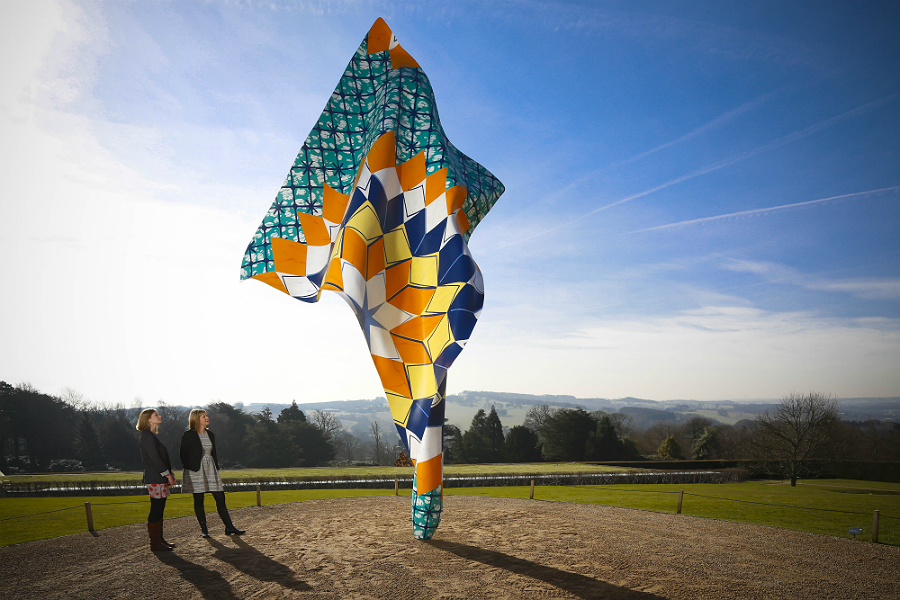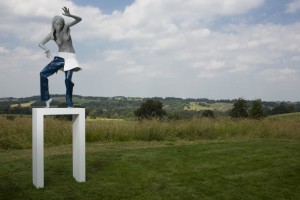A Day in the Country:
Yorkshire Sculpture Park

With artwork sat side-by-side with nature, Emma Sumner finds Yorkshire Sculpture Park is exactly what it’s cracked up to be…
There’s no other place in the world like Yorkshire Sculpture Park, or so the flyer drumming up donations states, but truthfully, there isn’t! Located in the 500 acre Bretton Estate in West Yorkshire, it’s a place which allows its visitors a more personal and tactile engagement with artworks that are so often untouchable in the gallery setting.
Although the vast space makes for an adventurous day out, it does also make picking up the park’s map obligatory to planning your visit; essential for getting the most out of your trip and for not getting lost. The other essentials of course are comfortable footwear and sensible clothing.
After finding a parking space (the attendant giving me nine out of ten for my parking) and studying the park’s map, we decide to start our art adventure at the Longside Gallery. The short brisk trek over the Yorkshire countryside to the opposite side of the park is scattered with works by 20th century and contemporary artists.
At one point I’m faced with the oversized words, Everything is Connected, a sculpture by Peter Liversidge. Its billboard quality looks drastically out of place – almost alien-like in the natural landscape. A little further and we come across Nikki de Saint Phalle’s Buddha, an imposingly cheerful figure who sits deep in meditation. A mosaic of mirror, glass and stone, he glistens in the sunshine, a typical example of Saint Phalle’s later work.
The Longside Gallery is nothing grand, but its defining feature is the long window which frames the unending view of the Yorkshire countryside we have just trekked across. It’s the kind of exhibition space that I expect sceptics to visit and comment that the view is better than the art. Incredible though the view is, I’m more immersed in the exhibition which cleverly communicates with its vista.

This is Lucy + Jorge Orta’s work. A result of their numerous global research trips, it looks deeply at a number of sustainability and environmental issues. Water is central to the Orta’s practice and on display is Drink Water!, a project the duo did for the 2005 Venice Biennale. This involved purifying lagoon water and convincing people to partake of its goodness, Jorge believing that “small actions can change the world”.
Moving on we trek back through the woodland, where we come across Basket #7, a sculptural structure by Winter/Hörbelt, labelled a place for ‘reflection and rest’. Who are we to argue? Climbing to the top of the tower we look out over the landscape through the meshed walls, deciding to make camp and eat lunch.
YSP is unquestionably a place for packed lunches (thought there is a cafe). Fully absorbed in the landscape and the art, you need to be able to sit down whenever your stomach tells you to eat without breaking your experience.
Seeing the landscape in this way is disorientating; the installation architecture pushes you through tight, intimate spaces, whilst allowing nature’s elements to breeze past, creating a sensory illusion of being outside yet inside.
After lunch we continue our trek through the woodland using David Nash’s practical sculpture, Seventy One Steps, to descend back into the main parkland. It feels idyllic as we walk past streams where sheep quench their thirst and dragonflies hover. Then I notice that these are no ordinary sheep; they have been graffitied as part of Alison Cooper’s Right to Roam. Wandering through the fields, sheep amble by and congregate like live flash cards creating phrases and sentences – most often quite absurd.
Heading back towards the centre, we stop for a moment’s rest and recuperation in James Turrell’s Deer Shelter Skyspace. An artist using light and space to create his installations, Turrell often baffles senses. Sitting back, I stare up at the ceiling – a large open square space which lets the audience view the sky. Housed in the park’s grade II listed deer shelter, the space is one in which visitors can stop and take time to contemplate the one part of the landscape they had possibly previously taken for granted … the sky above.
Back at the centre, we are introduced to the work of Yinka Shonibare MBE with a selection of his Shit Drawings. Large, powerful works, they tackle issues around climate change, but provide a mere morsel of what we are to expect from Shonibare’s largest exhibition to date, Fabric-ation. Shonibare’s work explores the themes and impact of colonialism, alongside issues of race and class.
Exhibiting a selection of Shonibare’s hilarious and garish satire installations from the past decade, you can feel his presence within the gallery, dictating to his brightly dressed mutant creatures, steering them to create the comical scenes, their tactile nature flirting with undermining the gallery’s no-touch policy.
The final film in the exhibition; Un Ballo in Maschere (A Masked Ball) really defines this idea. Like a colourful silent version of Blackadder (if that makes sense), the dancers enact his script to beautiful effect.
My personal highlight, and the reason I made the journey here, was to see Roger Hoirns’s Seizure, created by Hoirns in 2008 by pumping 75,000 litres of liquid copper sulphate into a former Southwark Council flat.
Bolted together with a web of steel girders it was moved overnight on the back of a truck to be re-housed at the YSP in a purpose-built space designed to keep the work at an optimum temperature. After being given protective stretchy-over shoes, a health and safety briefing and background talk on the work we are allowed to enter.
It’s strange, but I’m not sure how to describe the experience. This crystallised version of what was once someone’s home makes me think that if we all disappeared and left nature to do its thing, this is what might happen. It reminded me slightly of childhood visits to underground caves that had formed groups of stalagmites and stalactites, and worth visiting the YSP for this alone.
Finishing our visit with a walk along the upper garden, it’s a massive contrast to the rest of the park and feels more in keeping with a stately home – possibly because of its well kept pear trees and neatly trimmed lawn, with signs to keep off the grass echoing this sentiment.
Appropriately, the gallery spaces on this upper level are more conservative too. Although not to my personal taste, I’m revitalised by Shoniba’s wind sculpture and the view of the Yorkshire countryside mottled with sunshine and a mixture of different crops and tree formations; a sort of sculpture in its own right.
I have inadvertently skipped over the work of the two main players housed with the park’s grounds: Henry Moore and Barbara Hepworth. Not that I don’t appreciate their work, far from it, it just feels that the permanent fixtures of Moore and Hepworth are shapes we have come to know so well that they seem part of everyday life.
As a result, I don’t think anything will make me excited by Moore or Hepworth in the same way I was by Liversidge’s Everything is Connected. An experience like no other, a visit to the YSP will give you a brisk walk in the countryside while also providing that cultural booster shot you may’ve been lacking.
Emma Sumner
Yinka Shonibare MBE: Fabric-ation Until 01/09; Lucy + Jorge Orta Until 03/11; Roger Hoirns: Seizure, 2008/2013 @ Yorkshire Sculpture Park
Photos Jonty Wilde, courtesy Yorkshire Sculpture Park





